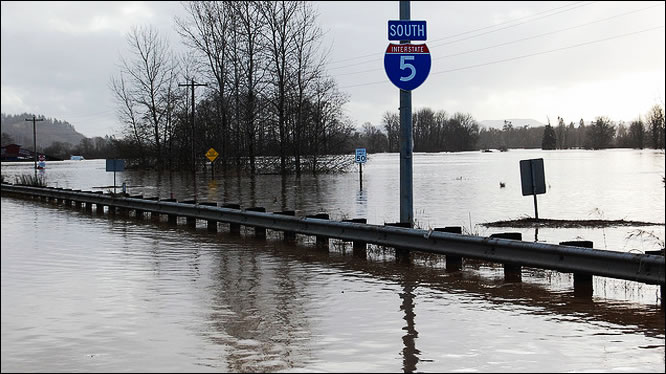
The heavy rain and rapid snowmelt combined to produce record and near-record flooding, mudslides, and avalanches. More than 2,600 homes were flooded, dozens of bridges were lost, an estimated $120 million in damages, and 3 fatalities occurred in Washington.
The affected counties were Adams, Asotin, Benton, Clark, Columbia, Cowlitz, Garfield, Grays Harbor, King, Kitsap, Kittitas, Klickitat, Lewis, Lincoln, Pierce, Skagit, Skamania, Snohomish, Spokane, Thurston, Wahkiakum, Walla Walla, Whitman and Yakima. The affected rivers were the Cedar, Chehalis, Columbia, Cowlitz, Klickitat, Naches, Nisqually, Palouse, Skokomish, Skookumchuck, Snoqualmie, Walla Walla, Yakima Rivers; 13 rivers and a creek saw record floods. This flood resulted in the highest flood of record on many southwest Washington rivers, most notably the Chehalis, Skookumchuck, and Nisqually.
 |
 |
 |
| Cedar River, Renton. Photo courtesy of King County |
Yakima River. Photo courtesy of Yakima County |
Snohomish River. Photo courtesy of King County |
Stampede Pass in the central Washington Cascades received an all-time daily record rain total of 8.22 inches on Nov 6, breaking the old record of 7.29 inches set on Nov 19, 1962. In addition, several other locations broke daily rainfall records. They included SeaTac Airport with 3.29 inches (old record 0.99 inches in 1990), Olympia with 4.31 inches (old record 1.74 inches in 1980) and Quillayute Airport near Forks with 2.38 inches (old record 1.92 inches in 1999). Additionally, June Lake and Swift Creek near Mt St Helens had 24-hour precipitation totals of 15.20 inches and 14.60 inches respectively on Nov 7th. During the overall event, June Lake received 38.20 inches, Swift Creek 36.40 inches and Sheep Canyon 28.00 inches.
The heavy rainfall amounts led to widespread flooding involving nearly all western Washington rivers and four rivers east of the Cascades. NWS Seattle (41), NWS Portland (6), NWS Spokane (1) and NWS Pendleton (4) issued flood warnings for 52 flood warning points throughout the state during the event. In all, 15 western Washington rivers reached all-time record flood crest levels. In addition for smaller streams, urban and small stream flood advisories and areal flood warnings were issued by both NWS Seattle and Portland forecast offices. All streams naturally returned to within their banks by November 11. There was more than $70 million in damages.
The Skagit River at Concrete reached 39.79 ft. or 145,000 cfs, which was only the sevneth highest level in the post-dam era, but nearly 15 ft. above flood stage. That compares with the Grand Daddy Flood in the early 1800s before European settlers, when a flood of around 69.3 ft., 510,000 cfs occurred somewhere around the year 1815, according to the Native Americans living in the area. That is more than 11 times the flood flow of 45,000 cfs, and over 44 feet above flood stage.
Learn More:
 |
 |
| December 4, 2007. Washington Dept. of Transportation. Landslide near McCormick, WA. |
Flood damage to Interstate 5 near Chehalis,WA on Dec. 4, 2007. WSDOT photo. |
Learn More:
 |
 |
| A mudslide covers Highway 542 near Deming, Wash. (Photo courtesy of WSDOT) |
January 2009 flooding aerial view. Photo courtesy of WSDOT. |
 |
 |
| As reported by Sacramento Bee. Date is misprinted as 2008 instead of 2009. |
Yakima River Flooding January 2009. |
Learn More:
| Flood Hazard Information NWS Forecast Offices and River Forecast Centers (RFC) Covering Washington | ||